Savvas Learning Co Geometry Student Edition Chapter 1 Tools of Geometry Exercise 1.2 Points Lines and Planes
Page 16 Exercise 1 Problem 1
Given:
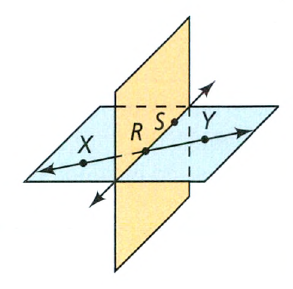
To find what are two other names for \(\overleftarrow{X Y}\).
Using the method geometrical representation.
From the given
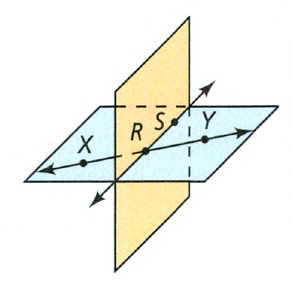
A line is named by any two points (in any order) on the line such as AB or by a single lowercase such as line l.
\(\overleftarrow{X Y}\) can also be named as \(\overleftarrow{Y X}\) or \(\overleftarrow{X R}\) or \(\overleftarrow{R X}\) or\(\overleftarrow{R Y}\) or\(\overleftarrow{Y R}\)
The other names for \(\overleftarrow{X Y}\) are\(\overleftarrow{Y X}\) or \(\overleftarrow{X R}\) or \(\overleftarrow{R X}\) or\(\overleftarrow{R Y}\) or\(\overleftarrow{Y R}\)
Page 16 Exercise 2 Problem 2
Given:

To find what is the intersection of the two planes.
Using the method of intersecting function.
Let
By Postulate 1−3, if two distinct planes intersect, then they intersect in exactly one line.
Here, the two planes intersect in \(\overleftarrow{R S}\) or \(\overleftarrow{S R}\).
The intersection of the two planes is \(\overleftarrow{R S}\) or \(\overleftarrow{S R}\)
Page 16 Exercise 3 Problem 3
Given: Ray, \(\overline{AB}\)and \(\overline{AB}\)
To find the given rays are same.Using the method Functions of Ray.
A ray is a part of a line that has one endpoint and goes on infinitely in only one direction. Cannot measure the length of a ray.
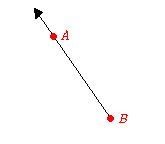
A ray is named using its endpoint first, and then any other point on the ray (for example \(\overline{B A}\)).
These two are not the same ray because their directions are different. One starts at A then moves towards B and continues in the direction of B.
The other starts at B and goes toward A continuing in A’s direction.
The Rays \(\overline{A B}\) and \(\overline{A B}\) are not same
Page 16 Exercise 4 Problem 4
Given: \(\overleftarrow{E F}\)
To explain about two arrowheads.Using the method Functions of Line.
Can say that a line is an infinitely thin, infinitely long collection of points extending in two opposite directions.
When draw lines in geometry, use an arrow at each end to show that it extends infinitely
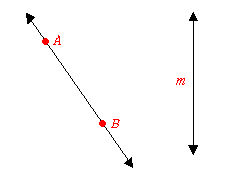
A line can be named either using two points on the line (for example,\(\overleftarrow{A B}\)).
Arrowheads are used to imply that the lines extend infinitely in both directions.
Arrowheads are used to imply that the lines extend infinitely in both directions.
Page 16 Exercise 5 Problem 5
Given: Ray and Line.
To Differentiate.
Using the method Functions of Ray and Line.
The naming of a ray and a line is similar in the sense that use two points named by letters to name each.
However, with a line the order of the letters does not matter because the line continues in both directions beyond these points.
A ray on the other hands has a specific direction, so the order of the letters determines which ray have named because the first letter is always the endpoint with the second letter being the direction in which the ray continues.
The naming of a ray and a line is similar in the sense that use two points named by letters to name each. The order of the letters determines which ray have named because the first letter is always the endpoint with the second letter being the direction in which the ray continues.
Page 16 Exercise 6 Problem 6
Given:
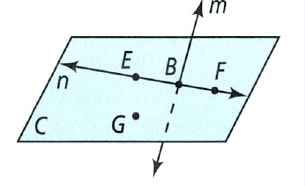
To find other ways to name plane C.
Using the method Functions of Plane.
Given
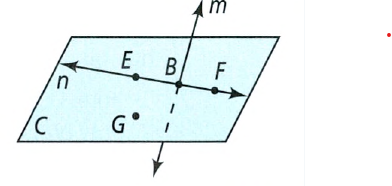
Can name a plane either by a letter or by a sequence of 3 noncollinear points which belong to the plane (because3 noncollinear points uniquely determine a plane):GEB, GEF, GEF.
The other way to name plane C is,GEB,GBF,GEF.
Page 16 Exercise 7 Problem 7
Given:
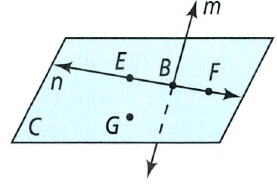
To name three collinear points.
Using the method Functions of collinear.
Three or more points that lie on the same line are collinear points.

The points A,B and C lie on the line m they are collinear.
The points D,B and E lie on the line n they are collinear.
There is no line that goes through all three points A,B and D.
So, they are not collinear.
In this given Figure

Collinear points are,E,B and F because that are all on line n.
Collinear points are E,B and F.
Page 16 Exercise 8 Problem 8
Given:
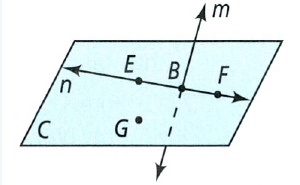
To name coplanar points.
Using the method Functions of Coplanar.
Points or lines are said to be coplanar if they lie in the same plane.

The points P,Q and R lie in the same plane A.
They are coplanar.
In the given plane
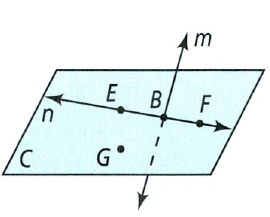
G,E,B and F are all coplanar because they are on plane C .
In the given plane G,E,B and F are all coplanar because they are on plane C.
Page 16 Exercise 9 Problem 9
Given:
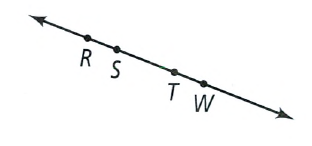
To name the segments.
Using the method Functions of Line segment.
A line segment has two endpoints.
It contains these endpoints and all the points of the line between them.
Can measure the length of a segment, but not of a line.
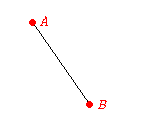
A segment is named by its two endpoints, for example \(\overline{A B}\)).
A segment is any two points that form part of a line. They go from one point to the other, with each point acting as an end point.
Therefore have to name all of the segments that are unique, meaning that they are between different points, and in doing so get all of the ones.
The segments of the figure are, \(\overline{R S}, \overline{S T}, \overline{T W}, \overline{R W}, \overline{W S}, \overline{T R}\)
The segments of the figure are, \(\overline{R S}, \overline{S T}, \overline{T W}, \overline{R W}, \overline{W S}, \overline{T R}\)
Page 16 Exercise 10 Problem 10
Given:
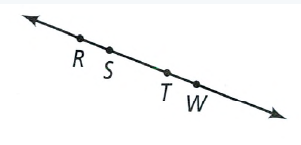
To name the rays in the figure.
Using the method Functions of Ray.
Example for Ray
A ray is a part of a line that has one endpoint and goes on infinitely in only one direction. Cannot measure the length of a ray.
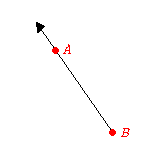
A ray is named using its endpoint first, and then any other point on the ray (for example \(\overline{B A}\)
To ensure that name every ray have to treat each point as an endpoint for a ray and then follow it in both directions or the line, finding a second point (if there is one) to name it by. The reason don’t name both \(\overline{R S}\) and \(\overline{R T}\) as rays is because they have the same endpoint and then continue in the same direction, making them the same ray.
Therefore these rays would also be acceptable answers in place of another that describes the same ray.
The rays in the given figure are \(\overline{R S}, \overline{S R}, \overline{S T}, \overline{T S}, \overline{T W}, \overline{W T}\)
The rays in the given figure are \(\overline{R S}, \overline{S R}, \overline{S T}, \overline{T S}, \overline{T W}, \overline{W T}\)
Page 16 Exercise 11 Problem 11
Given:
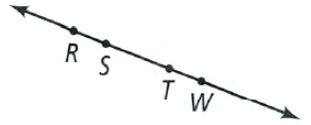
To name the pair of opposite rays with endpoint T.
Using the method of endpoint function.
Let
Opposite rays are rays that share the same endpoint, but continue along the line in different directions.
Instead of \(\overline{T S}\) we could have also named this ray as \(\overline{T R}\) , because they both describe the same ray that starts at T and continues in the direction of R and S .
The pair of opposite rays with endpoint \(\overline{T R}\)and \(\overline{T R}\).
Page 16 Exercise 11 Problem 12
Given:
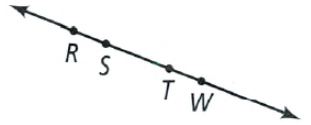
To name another pair of opposite rays.
Using the method of endpoint function.
Let
Opposite rays are rays that share the same endpoint, but continue along the line in different directions.
Instead of \(\overline{T S}\) we could have also named this ray as \(\overline{T R}\) because they both describe the same ray that starts at T and continues in the direction of R
and S.
The another pair of opposite rays is TW.
Page 16 Exercise 12 Problem 13
Given planes UXV and WVS.
To name the intersection of each pair of planes.
Using methods of geometry.
If two distinct planes intersect, then they intersect in exactly one line.
Here UXV and WVS intersect at \(\overrightarrow{V W}\).
In the figure the plane UXV and WVS intersect at \(\overrightarrow{V W}\).
Page 16 Exercise 13 Problem 14
Given planes XWV and UVR.
To name the intersection of each pair of planes.
Using methods of geometry.
If two distinct planes intersect, then they intersect in exactly one line.
Here, planes XWV and UVR intersect at \(\overrightarrow{U V}\).
In the figure the plane XWV and−URV intersect at \(\overrightarrow{U V}\)
Page 16 Exercise 14 Problem 15
Given plane TXW and TQU.
To name the intersection of each pair of planes.
Using methods of geometry.
If two distinct planes intersect, then they intersect in exactly one line.
The planes TWX and TQU intersect at \(\overrightarrow{X T}\).
In the figure the plane TWX and TQU intersect at \(\overrightarrow{X T}\).
Page 16 Exercise 15 Problem 16
Given line TU.
To name two planes that intersect in the given line.
Using methods of geometry.
If two distinct planes intersect, then they intersect in exactly one line.
Here, \(\overrightarrow{T S}\) is the intersection to the back and bottom face of the figure so a possible name pair for them are XTS and QTS.
In the figure the plane XTS, and QTS intersect at line \(\overrightarrow{T S}\)
Page 16 Exercise 16 Problem 17
Given Points R,V,W
To Shade the plane that contains the given points.
Using methods of geometry.
The possible plane is RSWV which contains the given points.

In the figure the shaded plane contains R,V,W points.
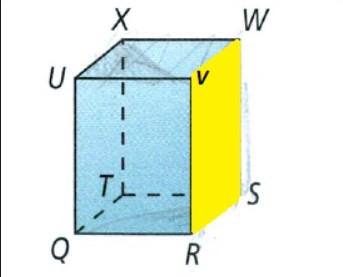
Page 16 Exercise 17 Problem 18
Given points U,V,W
To Shade the plane that contains the given points.
Using methods of geometry.
The possible plane is UVWX which contains the given points.
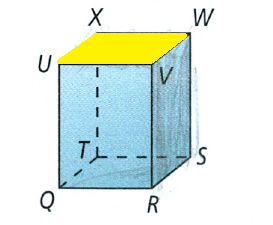
The shaded plane contain points U,V,W .
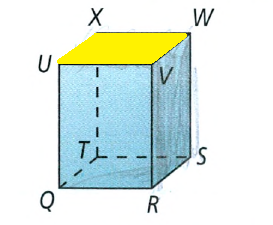
Page 16 Exercise 18 Problem 19
Given points U,X,X
To Shade the plane that contains the given points.
Using methods of geometry.
The possible plane is UXSR
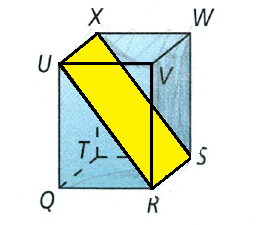
In the figure the shaded plane contains points U,S,X.

Page 16 Exercise 19 Problem 20
Given points T,U,V.
To Shade the plane that contains the given points.
Using methods of geometry.
The possible plane is STUV

In the figure the Shaded plane contain points T,U,V
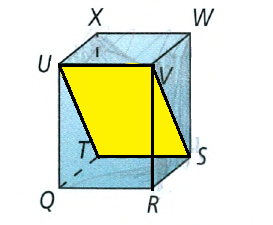
Page 17 Exercise 20 Problem 21
Given points S,U,V,Y
To determine whether the fourth point is in that plane.
Using methods of geometry.
The pointsS,U,V are in Blue plane.
The point Y is also in Blue plane.
Hence, point Y is co-planar to S,U,V.
The point Y is in Blue plane and co-planar to other points.
Page 17 Exercise 21 Problem 22
Given points X,Y,Z,U.
To determine whether the fourth point is in that plane.
Using methods of geometry.
Point Z lies in Yellow plane and other points are in Blue plane.
Hence non-coplanar.
The given points are non-coplanar.
Page 17 Exercise 22 Problem 23
Given points X,S,V,U
To determine whether the fourth point is in that plane.
Using methods of geometry.
All the 4 given points are in Blue plane.
Hence, the given points are co-planar.
The given points are co-planar.
